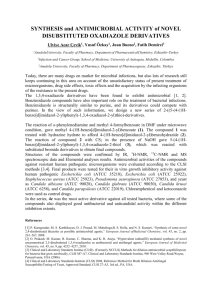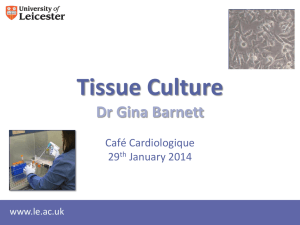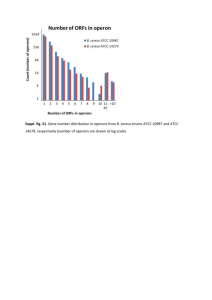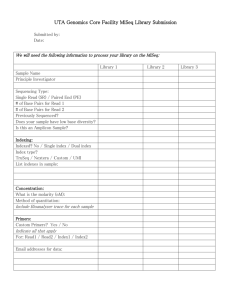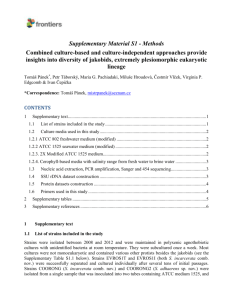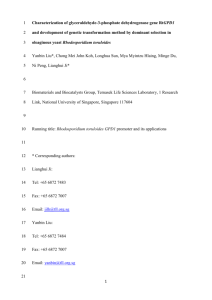Electronic Supplementary Material Moderate oxygen depletion as a
advertisement
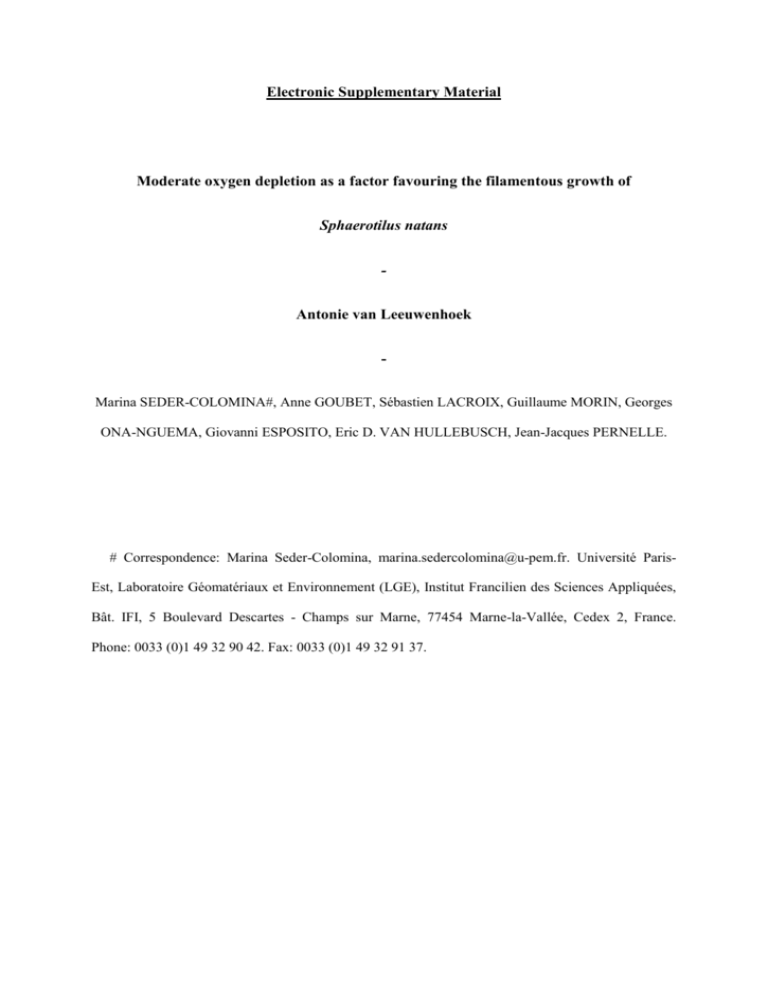
Electronic Supplementary Material Moderate oxygen depletion as a factor favouring the filamentous growth of Sphaerotilus natans Antonie van Leeuwenhoek Marina SEDER-COLOMINA#, Anne GOUBET, Sébastien LACROIX, Guillaume MORIN, Georges ONA-NGUEMA, Giovanni ESPOSITO, Eric D. VAN HULLEBUSCH, Jean-Jacques PERNELLE. # Correspondence: Marina Seder-Colomina, marina.sedercolomina@u-pem.fr. Université ParisEst, Laboratoire Géomatériaux et Environnement (LGE), Institut Francilien des Sciences Appliquées, Bât. IFI, 5 Boulevard Descartes - Champs sur Marne, 77454 Marne-la-Vallée, Cedex 2, France. Phone: 0033 (0)1 49 32 90 42. Fax: 0033 (0)1 49 32 91 37. S1 – Oxygen response of different Sphaerotilus strains Fig. S1 Qualitative distribution of single cells and filaments of five different strains of Sphaerotilus, () ATCC 29329 and 29330, () ATCC 15291, () ATCC 13338T, and () ATCC 13929. Observations were performed using optical microscopy at 500 after 24 hours of culture in CGY and NB 1% media Different strains of Sphaerotilus were grown in non-agitated broth, agitated broth and agar plates, in order to test their responses to an increasing oxygen availability. Qualitative changes in the ratio of single cells to filaments (the two morphotypes) under these three culture conditions were observed under the microscope. Results of this initial test showed that when cultured on agar plates, 4 of the 5 Sphaerotilus strains tested grew in the form of single cells. In addition, cultures in non-agitated broth resulted in mainly filaments. On the basis of these results, the hypothesis that a moderate oxygen depletion would favour the filamentous growth of S. natans was assumed. In order to verify this hypothesis, strain ATCC 15291 was selected for further experiments as it presented the broader dependence of the morphotype to oxygen concentration. S2 – Unsuitability of Turbidity/OD when studying S. natans dual morphotype Turbidity is estimated by optical density (OD), which measures light scattering (at 600 nm) by the microorganisms present in the suspension. However, OD is proportional to the number of cells only in homogeneous suspensions. For filamentous bacteria, these techniques may underestimate the quantity of cells, because filaments and single cells form aggregates spread in a non-turbid solution. Therefore, if the light beam does not cross any bacterial aggregate, the light is not scattered and the measured OD value is very low, underestimating the actual quantity of microorganisms. Fig. S2-1 Graphical example of the unsuitability of Turbidity/OD for filamentous biomass determination Optical density was measured for all cultures reported in our study. However, as is the case of filamentous microorganisms that form flocs (Fig. S2-2), such measurements were not reliable (see error bars, Fig. S2-3). Fig. S2-2 Photography of S. natans filamentous culture after 24 hours of incubation under passively aerated conditions Fig. S2-3 Optical density at 600 nm of Sphaerotilus natans grown under () passively and () actively aerated conditions, leading to filamentous and single-cell growth respectively, throughout 48 hours of incubation S3 – Filtration method Fig. S3 Filtration method developed for differential amplification by qPCR based on growth morphotypes S4 - Design of qPCR primers sthA New primers were designed here in order to ensure the validity of our results despite the dual morphotype of S. natans and to avoid the potential miscounting problems of total bacteria quantification. For instance, as S. natans single cells are optically indistinguishable from other rodshaped bacteria, if any other microorganism would colonized the growth media it would not be detectable by traditional microscopy and the counting would be inaccurate. In addition, 16S universal primers for qPCR of total bacteria would amplify all DNA present in the sample, existing hence the same potential inaccuracy problems as for microscopy. Therefore, specific set of primers amplifying S. natans was required to ensure the validity of the results. The set of primers targeting the sthA gene of S. natans 15291 was designed using Primer 3 software (http://bioinfo.ut.ee/primer3-0.4.0/) (Koressaar and Remm 2007; Untergasser et al. 2012). This sthA gene was previously identified by Suzuki et al. (Suzuki et al. 2002), and the sequence of sthA is deposited in GenBank (http://www.ncbi.nlm.nih.gov/genbank/index.html) under the accession numbers AB050638 and AB050640. The role of sthA in S. natans has been investigated by the disruption of the gene and the cultivation in a substrate-controlled media where filamentous growth was supposed to be induced. Microscopy images showed the absence of filamentation under such conditions which indicated that the sthA gene is involved in both sheath and EPS synthesis (Suzuki et al. 2002). The region amplified by the novel sthA set of primers was defined within the coding sequence, at a proximal location, near the start codon. The imposed parameters were: an amplicon size ranging between 140 and 200 nucleotides, a primer length of 20 nucleotides, Tm = 60 ± 1.5°C, a maximum self-complementarity of 4.00 and a maximum 3’ self-complementarity of 2.00. Each primer was tested using BLAST facilities (http://www.ncbi.nlm.nih.gov/BLAST/). The sequence of forward primer sthA-F is CGCTGCTCTATTCCTTCGTC and the one of reverse primer sthA-R is GGCGTAACCGTCATAGCTGA, generating an amplicon of 143 bp. The primers were synthesized by Eurofins MWG Operon (Ebersberg, Germany). To confirm the specificity of the designed primers, conventional PCR was run using DNA from different bacterial species of the Sphaerotilus-Leptothrix supergroup: S. natans (ATCC 15291, 13338 and 13929), Sphaerotilus hippei (ATCC 29330) (Gridneva et al. 2011) and Leptothrix cholodnii ATCC 5168 and 51169. The reaction mixture contained 2 µL of genomic DNA used as a template in 25 µL of PCR cocktail containing in final concentrations: sthA RP and sthA FP 900 nM, MgCl2 1.5 mM, dNTP 250 µM each and Therm start DNA polymerase (ABgene AB-0908) 0.625 U. Amplification was performed with the following cycling program: 15 min at 95°C; 40 cycles consisting of 30 sec at 94°C, 30 sec at 60°C, and 30 sec at 72°C; and elongation for 5 min at 72°C. No template controls (NTC) (2 µL of molecular biology grade water DNA-free) were also run. Tests were made in triplicate. The amplification products (of 143 bp expected) were separated in a 1.5% agarose gel electrophoresis and stained with ethidium bromide. Fig. S4 Agarose gel of PCR products amplified using the sthA set of primers. Lane 1: DirectLoad™ PCR Low Ladder, Sigma-Aldrich® (100-1000 bp), 2: Empty well, 3: Sphaerotilus natans ATCC 15291, 4: S. natans ATCC 13338, 5: S. natans ATCC 13929, 6: Sphaerotilus hippei ATCC 29330, 7: Leptothrix cholodnii ATCC 51168, 8: L. cholodnii ATCC 51169, 9: NTC (negative control) Results show that amplification was successful for all tested S. natans species (ATCC 15291, 13338 and 13929) for which a single band containing around 140 bp fragments was observed. In contrast, no amplification was observed either for other species of the same genus (S. hippei ATCC 29330) or the same supergroup (L. cholodnii ATCC 5168 and 51169). These results indicate that the sthA set of primers is able to amplify a specific region of S. natans DNA. Indeed, it is enough sensitive to distinguish between species from the Sphaerotilus genus. Bibliography Gridneva E, Chernousova E, Dubinina G, Akimov V, Kuever J, Detkova E, Grabovich M. (2011) Taxonomic investigation of representatives of the genus Sphaerotilus: descriptions of Sphaerotilus montanus sp. nov., Sphaerotilus hippei sp. nov., Sphaerotilus natans subsp. natans subsp. nov. and Sphaerotilus natans subsp. sulfidivorans subsp. nov., and an emended description of the genus Sphaerotilus. Inter J System Evolution Microbiol. 61: 916–925. Koressaar T, Remm M. (2007) Enhancements and modifications of primer design program Primer3. Bioinformatics 23: 1289–1291. Suzuki T, Kanagawa T, Kamagata, Y. (2002) Identification of a gene essential for sheathed structure formation in Sphaerotilus natans, a filamentous sheathed bacterium. Appl Environ Microbiol 68: 365–371. Untergasser A, Cutcutache I, Koressaar T, Ye J, Faircloth BC, Remm M, Rozen SG. (2012) Primer3 – new capabilities and interfaces. Nucleic Acids Res. 40: e115.
